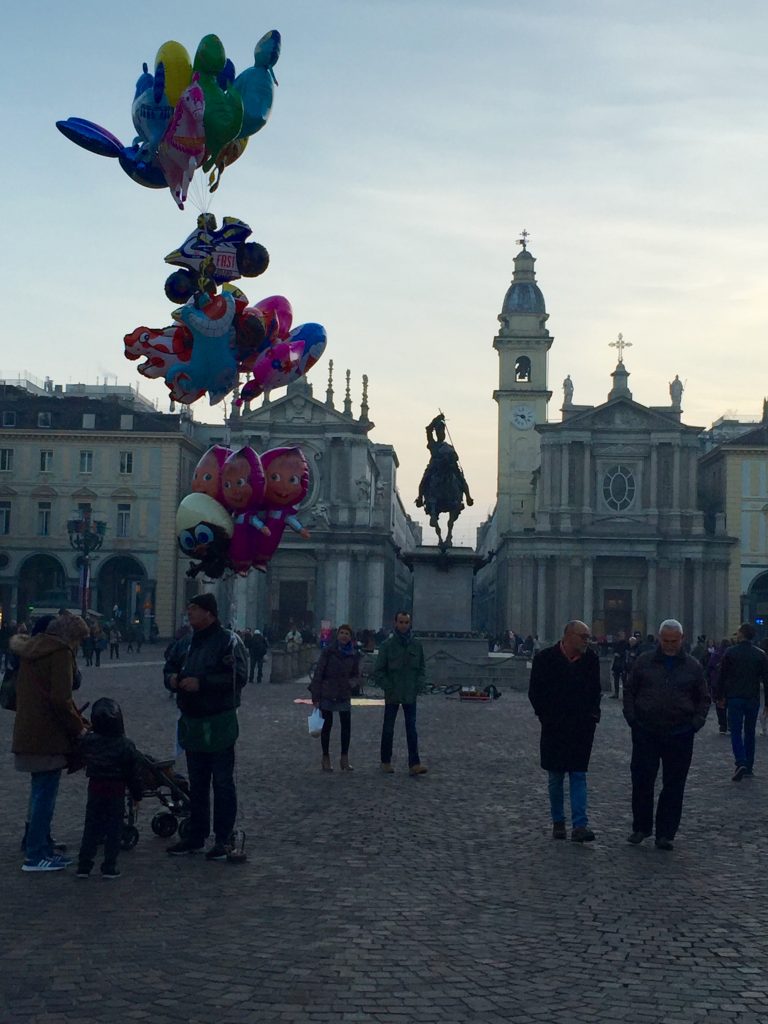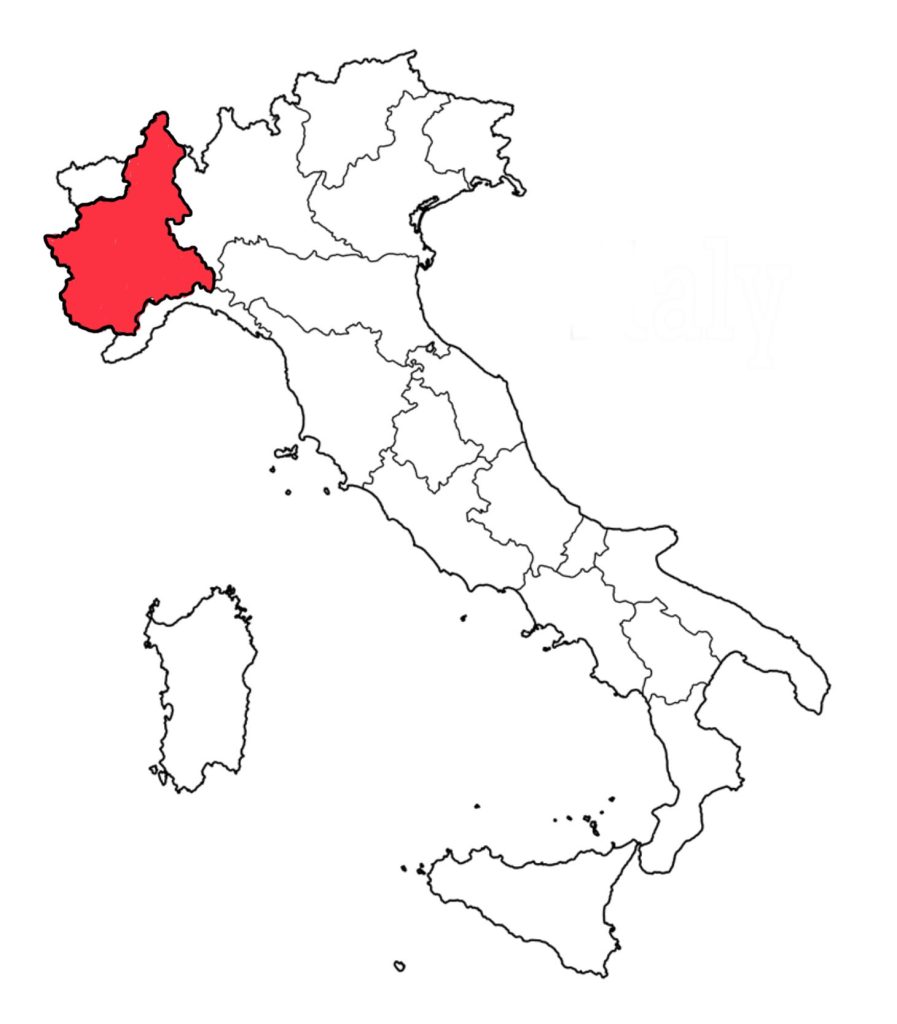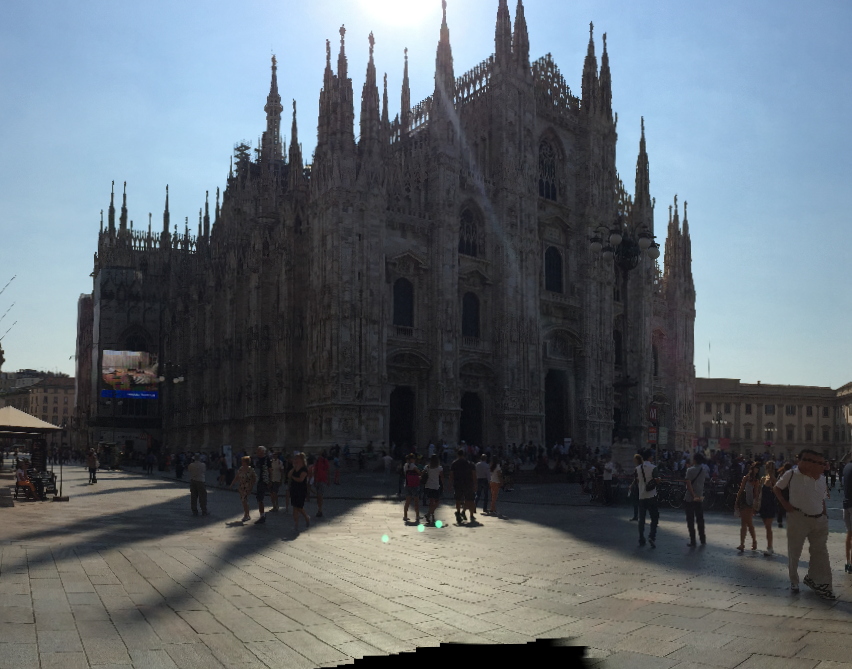Les Plus Courtes Folies Sont Les Meilleures! Part 2
It’s Sunday morning. An early breakfast of a brioche and a cappuccino at the bar facing the Duomo, and we’re off by taxi to the Stazione Centrale, Milano’s inner city train station.
One last look over my shoulder as we pull away stays with me as a snapshot in black and white of looming spires perforating the veil of fog and disappearing into the early morning sky.
The train station is overflowing with people and activity. Unusual for a Sunday morning. We purchase our train tickets for Torino and rolling our carry-ons through the crowds and up to the departure platform, we board the Freccia Rossa for our next adventure.
Barely an hour away, —-much too short to be able to catch up on some sleep—–an electronic and impersonal voice announces our stop.
Torino, sitting on the left bank of the Po River, is a splendid grande dame with its elegant tree-lined boulevards, opulent Art Nouveau cafés and baroque piazzas. I am happy to revisit even for a brief time; to take in the numerous art galleries, restaurants, churches, palaces, opera houses, piazzas, parks, gardens, theatres, libraries, and museums would require a lifetime or at least an extended stay. My friends and I decide that this short sojourn of ours will focus on visiting the cafes, luxuriating in chocolate and all its derivatives, and just simply taking in Turin’s charm and gentility. We only have two days.

Our hotel is just outside the train station. A hop to the corner, a crossing of the street and we’re there. The Turin Palace Hotel presents a marvelous and contemporary lobby, but when we are shown to our rooms, well, we are flabbergasted. One of the perks of travelling with friends is being able to share a room; so we opt for the luxury suite! It’s a beautifully appointed room with enough space for three women to cohabit; makeup bags, bottles of age defying creams, perfumes, and sundry shoes, all cleverly packed in a small carry-on tote along with jeans and sweaters, are easily and fashionably strewn over the upholstered chairs, two queen sized beds and in the large closet. And the room still feels capacious and comfortable.
We rush out, eager to take in this elegant Torino on a Sunday morning. A twist and turn down the street and we are on the Via Roma, a grand boulevard under a cover of arcades. It has become one of the main shopping routes of the city, lined with mainly fashion stores and jewelry boutiques. This morning, those strolling are stylish couples out for a morning walk, those coming or going to church, seniors walking their small dogs or, like us, people on their way to one of the many cafés that serve the famous chocolate coffee drinks. We are not so focused on our destination, however, that we cannot be detracted from slipping into a little shop for some small souvenirs. One window in particular, is glinting from the shafts of bright sunlight that hit the glass and create a kaleidoscopic burst of argentine lights. Silver of every shape and form is handsomely displayed so to coax the window shoppers into the store. Of course! We’ll just go in for a peak, we tell ourselves, and being the women we are, are easily persuaded to buy ourselves each a little silver spoon; for sugar, for jam, or simply as a little reminder of a leisurly stroll through the streets of Torino.
We weave our way through the Sunday morning streets: the pace is slow; the air is crisp and invigorating and infused with the rich aroma of freshly made cappuccinos wafting from the many café bars we pass. People are already gathering for the pre-lunch aperitivo. Their talk, defined by some unspoken contract, is drone-like, and muted; it’s a lazy drawl, respectful of the “day of rest”.

On the Via Giuseppe Luigi Lagrange, we find ourselves in front of Eataly, and decide it’s time for lunch. The first floor is filled to capacity so we descend to the basement floor and amidst crowds jockeying for a table, we manage to sit in a far corner. Utensils and napkin are cleverly concealed in a paper pouch. Immediately a server comes by with menus: all three of us choose the same dish: Baccalà Mantecato, which when it arrives is presented in a most inventive way: in a short mason jar to keep it hot. The dried and salted “stockfish” cod, whipped with potatoes sits atop a layer of hot polenta. Yummy and delightful.
We meander aimlessly on our way out captivated by shelves of olive oils from every part of Italy; pasta of every shape and size; colorful jars of vegetables; a myriad selection of vinegars and condiments; sacks of organic flours and grains; and other sundry gastronomic delights.
Once outside, the noonday sun warms and revives us. We set out once again to attempt to uncover the intriguing and flashy side of this very sober and seemingly sedate metropolis. Known for its erudition —this city has a university that dates back to 1404— Torino has long attracted great writers and thinkers. This is the home and headquarters of the Einaudi Publishing house that brought to it writers like Cesare Pavese and Italo Calvino, Umberto Eco and great thinkers like Antonio Gramsci. Bookshops, ancient and modern, abound, and there is a plethora of museums and art institutes and exhibits to visit. But we are here to experience the café culture that Torino is so well known for.
The Piazza San Carlo is not called the “salotto d’Italia” (Italy’s drawing room) for nothing: the grand cafés lining its sides below the porticoes once accommodated dukes and duchesses and dowagers in furs and high finery that murmured silently as they sipped their cordials or hot chocolates. Today these same cafés that safeguard the old world are still dripping with crystal and gleaming with gilt.

image by www.tripwolf.com
Our first stop is the Baratti & Milano Café, an historic meeting place characterized by extensive use of mirrors, marble, bronze, gilt and stucco that give the room a rich architectural and artistic elegance. Delicately carved wood shelves display confectionary of every kind including Torino’s famous gianduiotto, a small upturned boat-shaped chocolate made from a paste of sugar, cocoa and hazelnut.

We seat ourselves on red velvet settees and drink in the mocha infused air that prevails in the coffee bar. On the menu are a dozen coffee and chocolate concoctions to choose from: a marocchino, which is an espresso with dark chocolate powder added to it and frothed milk cream on top; a cioccolata classica con panna; a bicerin, a traditional hot drink native to Turin and made of espresso, melted chocolate and whole milk, served layered in a small rounded glass; or simply, a delicious espresso.
If a smile signifies a deeply satisfying experience, ours are beaming and broad as we leave the Baratti & Milano caffé and find ourselves in the exquisite glass covered Galleria Subalpina, a 19th century commercial space characterized by a large and bright oval shaped gallery with remarkable decorative eclectic elements of Renaissance and Baroque style. Here also, are housed a cinema, antique book dealers and a restaurant of some historical note.

The afternoon brings a mild chill, but protected by the magnificent porticoes under which we walk, we venture forth, unwilling to go inside any museum or exhibit. Sometimes when travelling and time is brief, the best way to experience a city is to allow yourself simply to absorb it; to take in its smells and sounds; to let your eye dwell on small details like crenellations in walls, and friezes on doors. Torino has all this and more in which to immerse oneself.
We visit the Mole Antonelliana, an imposing building with a high pinnacle, a one time synagogue, and the major landmark associated with Torino. Today the Mole houses the Museum of Cinema, and an elevator riding to its peak takes you to the best view of this interesting city below. Visible in the distance is Superga, —one of the highest hills on the outskirts of Torino—-, and its basilica, standing tall overlooking the Piedmontese capital.

The mists rising from the Po begin to envelop the countryside. I take in the sweeping panorama below and discover a city at once regal and dignified; a city which conceived the idea of a unified country and then gave birth to the Risorgimento of Italy. I get emotional at the thought, and turn my back to wipe away a tear of maudlin pride.

My troupe and I figure that we need one more fix of chocolate for the road, and head out to the famous Caffé Al Bicerin, where, just walking through the doors of this miniscule café bar, one might immediately imagine herself or himself transported to the nineteenth century. As we enter we are immediately consumed by the scent that suffuses the room. We sit at a tiny table, perhaps the same one where Cavour sat sipping his bicerin. This concoction of bittersweet chocolate, coffee, and cream of milk was born here, in this place that bears its name and has become the symbol of Torino.
The day is dwindling and soon our little jaunt will be over. We walk wordlessly back to our hotel under the constant flow of arcades. I remember having read once that the artist Giorgio de Chirico had once visited Torino early in the 20th century. He had been deeply moved by his brief experience here, and wrote ‘Turin is the most profound, most enigmatic and most disquieting city, not only of Italy but of the world”. I think of his paintings: the shadows, the silence weaving through the porticoes, and with one last look back, I feel at once in communion with him.











0



